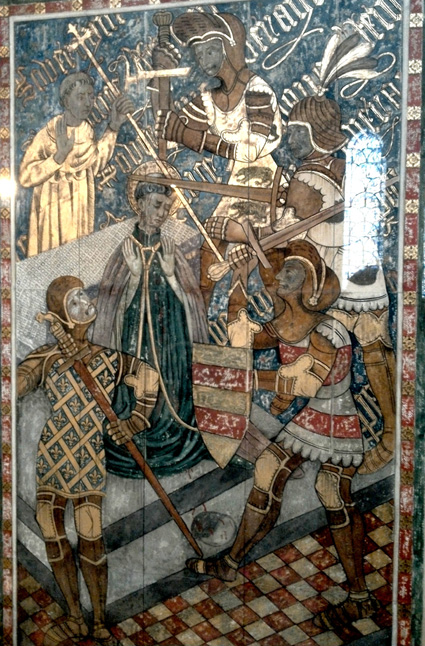|
|
Canterbury Cathedral |
|
|
Canterbury Cathedral |
CANTERBURY was the primatial see of England from the arrival of St. Augustine of Canterbury in 598 until the death of Cardinal Reginald Pole, the last Catholic Archbishop of Canterbury, in 1558.
DURING the middle ages the Cathedral was one of the most popular pilgrimage sites in Europe, since it had been the scene of the martyrdom of St. Thomas Becket in 1170. Pilgrimage ceased when the saint's shrine was dismantled by order of King Henry VIII in 1538.
|
|
|
|
GATE to CATHEDRAL CLOSE (precincts) |
CATHEDRAL (West End - seen through gate) |
|
|
|
|
CANTERBURY CATHEDRAL |
CATHEDRAL NAVE |
|
|
|
|
ENTRANCE to the CHOIR |
LANTERN in the EAST TOWER |
THE assassination of St. Thomas Becket by barons of Henry II in 1170 transformed Canterbury an important site of pilgrimage, commemorated in Chaucer’s Canterbury Tales. The shrine containing St. Thomas’ relics was originally located in the crypt of the cathedral, then later moved (to accomodate the increasing crowds of pilgrims) into a large space behind the choir in the east end with a surrounding ambulatory, permitting pilgrims to circulate freely during liturgies.
 |
|
| MARTYRDOM of ST. THOMAS BECKET |
ARCHBISHOP
(possibly Thomas Becket) |
|
|
|
|
THE
SITE of
BECKET'S
MARTYRDOM |
CRYPT CHAPEL |
|
|
|
|
CRYPT
CHAPEL
|
MARIAN
CHAPEL
in the CRYPT |
|
|
|
|
CHOIR |
ALTAR and ARCHBISHOP'S THRONE |
THE shrine of St. Thomas Becket was dismantled in 1538 as part of the English Reformation, but the fate of his relics remains obscure. A century later, during the reign of Thomas Cromwell as “Lord Protector”, the French ambassador wrote that what little remained of Becket’s relics were at that moment being fired out of a canon in the spirit of Puritan piety, which abhorred any remnant of the veneration of saints. The site of Becket's shrine behind the cathedral choir is now bare and empty, the site marked only by a single lighted candle. Becket’s relics may, however, still be venerated in the Roman Catholic Church of St. Thomas, a few hundred yards from the cathedral.
|
|
|
FORMER SITE of BECKET'S SHRINE (now empty - note the lighted candle in the center) |
|
|
|
|
MIRACLES attributed to ST. THOMAS |
TREE of JESSE WINDOW |
|
|
|
|
CHAPTER ROOM |
CLOISTER |
|
|
|
|
CLOISTER |
CATHEDRAL CLOSE |
THE RUINS of St. Augustine’s Abbey, the original community founded by St. Augustine of Canterbury in 598, are located about a quarter of a mile east of the cathedral. The community was one of the oldest Benedictine monasteries in England at the time of its suppression by King Henry VIII in 1538. The king transformed part of the abbey into a palace for his fourth queen, Anne of Cleves. Part of the former abbey is now a school; the monastery church and cloister were dismantled and used as a quarry until 1844, when the first efforts were made at restoration and preservation of the site.
|
|
|
|
ABBEY RUINS |
ABBEY RUINS (choir and nave) |
|
|
|
|
CHOIR RUINS |
CHOIR RUINS |
|
|
|
|
CRYPT |
SITE
of St.
AUGUSTINE
of CANTERBURY'S |
THE POPULARITY of Canterbury as a site for pilgrimage created a need to accommodate large numbers of pilgrims. One of the best-maintained pilgrim-hostels is the Eastbridge “Hospital” (hostel), founded in the late twelfth century, shortly after Becket's assassination and canonization.
|
|
|
|
PILGRIM DORMTORY |
in the EASTBRIDGE HOSPITAL |
|
|
|
|
REFECTORY in the EASTBRIDGE HOSPITAL |
RESTORED WALL-PAINTING |
|
|
|
|
CHAPEL in the EASTBRIDGE HOSPITAL |
(another) CHAPEL in the EASTBRIDGE HOSPITAL |
This Webpage was created for a workshop held at Saint Andrew's Abbey, Valyermo, California in 2014